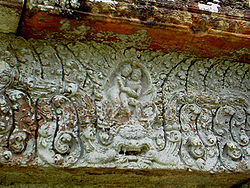Preah Vihear Temple
| Preah Vihear Temple | |
|---|---|
 |
|
| Name | |
| Proper name | Prasat Preah Vihear |
| Geography | |
| Coordinates | 14°23′35″N 104°40′49″E / 14.39306°N 104.68028°ECoordinates: 14°23′35″N 104°40′49″E / 14.39306°N 104.68028°E |
| Country | Cambodia |
| Province | Preah Vihear |
| Culture | |
| Primary deity | Shiva |
| Architecture | |
| Architectural styles | Banteay Srei style and others |
| History and governance | |
| Date built | 11th–12th centuries AD |
| Creator | Suryavarman I and Suryavarman II |
| Temple of Preah Vihear | |
|---|---|
| Name as inscribed on the World Heritage List | |
 |
|
| Location | Cambodia |
| Type | Cultural |
| Criteria | i |
| Reference | 1224 |
| UNESCO region | Asia-Pacific |
| Inscription history | |
| Inscription | 2008 (32nd Session) |
Preah Vihear Temple (Khmer: ប្រាសាទព្រះវិហារ Prasat Preah Vihea; Thai: ปราสาทพระวิหาร; rtgs: Prasat Phra Wihan) is an ancient Hindu temple built during the period of the Khmer Empire, that is situated atop a 525-metre (1,722 ft) cliff in the Dângrêk Mountains, in the Preah Vihear province, Cambodia. In 1962, following a lengthy dispute between Thailand and Cambodia over ownership, the International Court of Justice (ICJ) in The Hague ruled that the temple is in Cambodia.
Affording a view for many kilometers across a plain, Prasat Preah Vihear has the most spectacular setting of all the temples built during the six-centuries-long Khmer Empire. As a key edifice of the empire's spiritual life, it was supported and modified by successive kings and so bears elements of several architectural styles. Preah Vihear is unusual among Khmer temples in being constructed along a long north-south axis, rather than having the conventional rectangular plan with orientation toward the east. The temple gives its name to Cambodia's Preah Vihear province, in which it is now located, as well as the Khao Phra Wihan National Park which borders it in Thailand's Sisaket province and through which the temple is most easily accessible. On July 7, 2008, Preah Vihear was listed as a UNESCO World Heritage Site.
Prasat Preah Vihear is the compound of words Prasat, Preah and Vihear. Prasat (ប្រាសាទ) mean "castle", sometimes "temple"; in Sanskrit प्रासाद. Preah (ព្រះ) mean "sacred". "Vihear" (វិហារ) mean "shrine" (the central structure of the temple). The word Vihear could be related to the Sanskrit word Vihara (विहार) which means "abode."
...
Wikipedia
